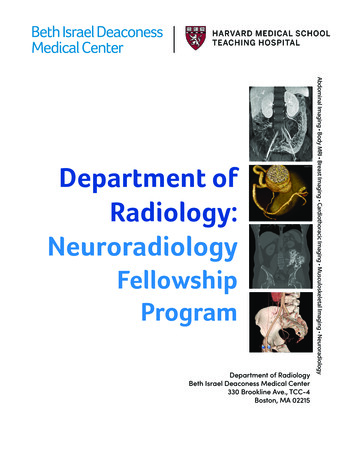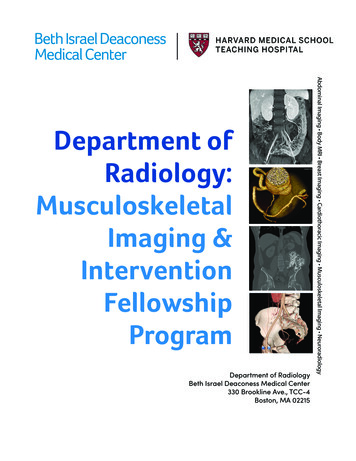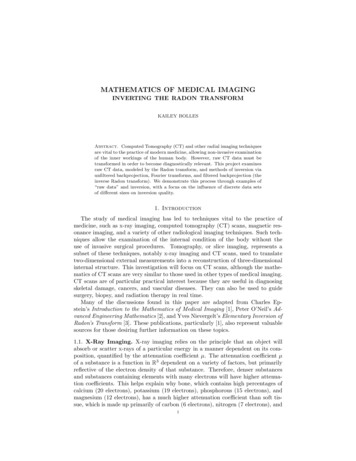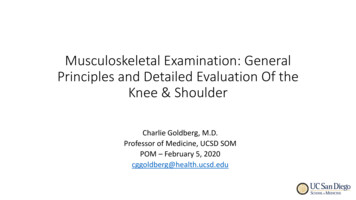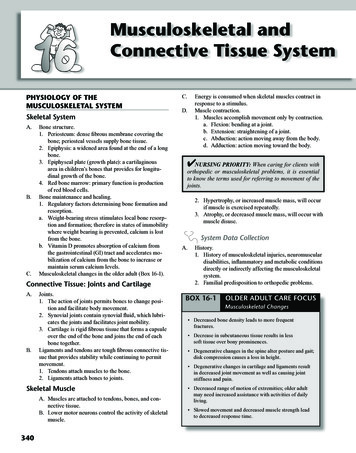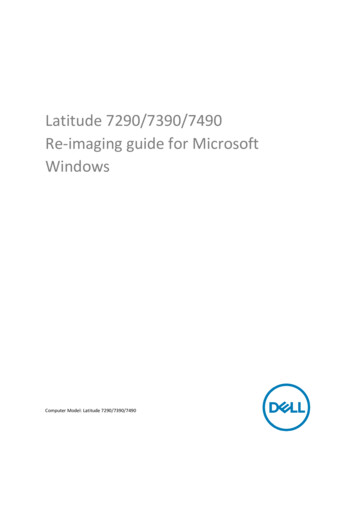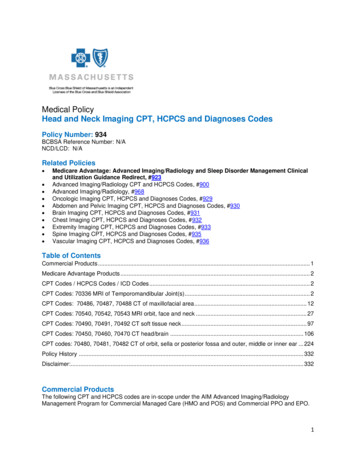
Transcription
CLINICAL GUIDELINESMusculoskeletal Imaging PolicyVersion 2.0Effective July 15, 2020eviCore healthcare Clinical Decision Support Tool Diagnostic Strategies: This tool addresses common symptoms and symptom complexes. Imaging requests for individualswith atypical symptoms or clinical presentations that are not specifically addressed will require physician review. Consultation with the referring physician, specialist and/orindividual’s Primary Care Physician (PCP) may provide additional insight.CPT (Current Procedural Terminology) is a registered trademark of the American Medical Association (AMA). CPT five digit codes, nomenclature and other data arecopyright 2020 American Medical Association. All Rights Reserved. No fee schedules, basic units, relative values or related listings are included in the CPT book. AMA doesnot directly or indirectly practice medicine or dispense medical services. AMA assumes no liability for the data contained herein or not contained herein. 2020 eviCore healthcare. All rights reserved.
Musculoskeletal Imaging GuidelinesMusculoskeletal Imaging GuidelinesProcedure Codes associated with Musculoskeletal ImagingMS-1: General GuidelinesMS-2: Imaging TechniquesMS-3: 3D RenderingMS-4: Avascular Necrosis (AVN)/OsteonecrosisMS-5: FracturesMS-6: Foreign BodyMS-7: Ganglion CystsMS-8: Gout/Calcium Pyrophosphate Deposition Disease(CPPD)/Pseudogout/ChondrocalcinosisMS-9: Infection/OsteomyelitisMS-10: Soft Tissue Mass or Lesion of BoneMS-11: Muscle/Tendon Unit Injuries/DiseasesMS-12: OsteoarthritisMS-13: Chondral/Osteochondral LesionsMS-14: OsteoporosisMS-15: Rheumatoid Arthritis (RA) and Inflammatory ArthritisMS-16: Post-Operative Joint Replacement SurgeryMS-17: Limb Length DiscrepancyMS-18: Anatomical Area Tables – General InformationMS-19: ShoulderMS-20: ElbowMS-21: WristMS-22: HandMS-23: PelvisMS-24: HipMS-25: KneeMS-26: AnkleMS-27: FootMS-28: Nuclear 55861636571778185 2020 eviCore healthcare. All Rights Reserved.Page 2 of 86400 Buckwalter Place Boulevard, Bluffton, SC 29910 (800) 918-8924www.eviCore.com
Musculoskeletal Imaging GuidelinesMRI Upper Extremity, other than joint, without contrastMRI Upper Extremity, other than joint, with contrastMRI Upper Extremity, other than joint, without and with contrastMRI Upper Extremity, any joint, without contrastMRI Upper Extremity, any joint, with contrastMRI Upper Extremity, any joint, without and with contrastMR Angiography Upper Extremity without or with contrastMRI Lower Extremity, other than joint, without contrastMRI Lower Extremity, other than joint, with contrastMRI Lower Extremity, other than joint, without and with contrastMRI Lower Extremity, any joint, without contrastMRI Lower Extremity, any joint, with contrastMRI Lower Extremity, any joint, without and with contrastMR Angiography Lower Extremity without or with contrastMRI Pelvis without contrastMRI Pelvis with contrastMRI Pelvis without and with contrastCT/CTACT Upper Extremity without contrastCT Upper Extremity with contrastCT Upper Extremity without and with contrastCT Angiography Upper Extremity without and with contrastCT Lower Extremity without contrastCT Lower Extremity with contrastCT Lower Extremity without and with contrastCT Angiography Lower Extremity without and with contrastCT Pelvis without contrastCT Pelvis with contrastCT Pelvis without and with contrastNuclear MedicineBone Marrow Imaging, LimitedBone Marrow Imaging, MultipleBone Marrow Imaging, Whole BodyBone or Joint Imaging LimitedBone or Joint Imaging MultipleBone Scan Whole BodyBone Scan 3 Phase StudyRadiopharmaceutical localization of tumor, inflammatory process ordistribution of radiopharmaceutical agent(s) (includes vascular flow and bloodpool imaging, when performed); planar, single area (eg, head, neck, chest,pelvis), single day imagingCPT 73721737227372373725721957219672197CPT 72194CPT 7810278103781047830078305783067831578800 2020 eviCore healthcare. All Rights Reserved.Page 3 of 86400 Buckwalter Place Boulevard, Bluffton, SC 29910 (800) 918-8924www.eviCore.comMusculoskeletal ImagingMRI/MRAProcedure Codes associated withMusculoskeletal ImagingV2.0
Musculoskeletal Imaging letal ImagingRadiopharmaceutical localization of tumor, inflammatory process ordistribution of radiopharmaceutical agent(s) (includes vascular flow and bloodpool imaging, when performed); planar, 2 or more areas (eg, abdomen andpelvis, head and chest), 1 or more days imaging or single area imaging over 2or more daysRadiopharmaceutical localization of tumor, inflammatory process ordistribution of radiopharmaceutical agent(s) (includes vascular flow and bloodpool imaging, when performed); planar, whole body, single day imagingRadiopharmaceutical localization of tumor, inflammatory process ordistribution of radiopharmaceutical agent(s) (includes vascular flow and bloodpool imaging, when performed); tomographic (SPECT), single area (eg, head,neck, chest, pelvis), single day imagingRadiopharmaceutical localization of tumor, inflammatory process ordistribution of radiopharmaceutical agent(s) (includes vascular flow and bloodpool imaging, when performed); tomographic (SPECT) with concurrentlyacquired computed tomography (CT) transmission scan for anatomicalreview, localization and determination/detection of pathology, single area (eg,head, neck, chest, pelvis), single day imagingRadiopharmaceutical localization of tumor, inflammatory process ordistribution of radiopharmaceutical agent(s) (includes vascular flow and bloodpool imaging, when performed); tomographic (SPECT), minimum 2 areas (eg,pelvis and knees, abdomen and pelvis), single day imaging, or single areaimaging over 2 or more daysRadiopharmaceutical localization of tumor, inflammatory process ordistribution of radiopharmaceutical agent(s) (includes vascular flow and bloodpool imaging, when performed); tomographic (SPECT) with concurrentlyacquired computed tomography (CT) transmission scan for anatomicalreview, localization and determination/detection of pathology, minimum 2areas (eg, pelvis and knees, abdomen and pelvis), single day imaging, orsingle area imaging over 2 or more daysV2.0 2020 eviCore healthcare. All Rights Reserved.Page 4 of 86400 Buckwalter Place Boulevard, Bluffton, SC 29910 (800) 918-8924www.eviCore.com
Musculoskeletal Imaging GuidelinesV2.0MS-1: General Guidelines Before advanced diagnostic imaging can be considered, there must be an initialface-to-face clinical evaluation as well as a clinical re-evaluation after a trial of failedconservative treatment; the clinical re-evaluation may consist of a face-to-faceevaluation or other meaningful contact with the provider’s office such as email, webor telephone communications. A face-to-face clinical evaluation is required to have been performed within the last60 days before advanced imaging can be considered. This may have been either theinitial clinical evaluation or the clinical re-evaluation. The initial face-to-face clinical evaluation should include a relevant history andphysical examination, appropriate laboratory studies, and non-advanced imagingmodalities. Other forms of meaningful contact (e.g., telephone call, electronic mail ormessaging) are not acceptable as an initial evaluation. Prior to advanced imaging consideration, the results of plain X-rays performed afterthe current episode of symptoms started or changed is required for allmusculoskeletal conditions, unless otherwise noted in the guidelines. Clinical re-evaluation is required prior to consideration of advanced diagnosticimaging to document failure of significant clinical improvement following a recent(within 3 months) six week trial of provider-directed conservative treatment. Clinicalre-evaluation can include documentation of a face-to-face encounter ordocumentation of other meaningful contact with the requesting provider’s office bythe patient (e.g. telephone call, electronic mail or messaging). Orthopedic specialist evaluation can be helpful in determining the need for advancedimaging. The need for repeat advanced imaging should be carefully considered and maynot be indicated if prior imaging has been performed. Serial advanced imaging, whether CT or MRI, for surveillance of healing orrecovery from musculoskeletal disease is not supported by the medical evidencein the majority of musculoskeletal conditions.References1. Reinus WR. Clinician’s guide to diagnostic imaging. NY. Springer Science. .2. Visconti AJ, Biddle J, and Solomon M. Follow-up imaging for vertebral osteomyelitis a teachablemoment. JAMA. 2014;174(2):184. doi: 10.1001/jamainternmed.2013.12742 2020 eviCore healthcare. All Rights Reserved.Page 5 of 86400 Buckwalter Place Boulevard, Bluffton, SC 29910 (800) 918-8924www.eviCore.comMusculoskeletal Imaging Provider-directed conservative treatment may include rest, ice, compression, andelevation (R.I.C.E.), non-steroidal anti-inflammatories (NSAIDs), narcotic and nonnarcotic analgesic medications, oral or injectable corticosteroids,viscosupplementation injections, a provider-directed home exercise program, crosstraining, and/or physical/occupational therapy or immobilization bysplinting/casting/bracing.
Musculoskeletal Imaging GuidelinesV2.0Musculoskeletal Imaging3. Fabiano V, Franchino G, Napolitano M, et. al. Utility of magnetic resonance imaging in the follow-upof children affected by actue osteomyelitis. Curr Pediatr Res. tis.pdf. 2020 eviCore healthcare. All Rights Reserved.Page 6 of 86400 Buckwalter Place Boulevard, Bluffton, SC 29910 (800) 918-8924www.eviCore.com
Musculoskeletal Imaging GuidelinesMS-2: Imaging TechniquesMS-2.1: Plain X-RayMS-2.2: MRI or CTMS-2.3: UltrasoundMS-2.4: Contrast IssuesMS-2.5: Positron Emission Tomography (PET)V2.088899 2020 eviCore healthcare. All Rights Reserved.Page 7 of 86400 Buckwalter Place Boulevard, Bluffton, SC 29910 (800) 918-8924www.eviCore.com
Musculoskeletal Imaging GuidelinesV2.0MS-2.1: Plain X-Ray The results of an initial plain X-ray are required prior to advanced imaging in allmusculoskeletal conditions/disorders, unless otherwise noted in the guidelines, torule out those situations that do not often require advanced imaging, such asosteoarthritis, acute/healing fracture, dislocation, osteomyelitis, acquired/congenitaldeformities, and tumors of bone amenable to biopsy or radiation therapy (in knownmetastatic disease), etc.MS-2.2: MRI or CT Magnetic Resonance Imaging (MRI) is often the preferred advanced imagingmodality in musculoskeletal conditions because it is superior in imaging the softtissues and can also define physiological processes in some instances [e.g. edema,loss of circulation (AVN), and increased vascularity (tumors)]. Computed Tomography (CT) is preferred for imaging cortical bone anatomy; thus, itis useful for studying complex fractures (particularly of the joints), dislocations, andassessing delayed union or non-union of fractures, if plain X-rays are equivocal. CTmay be the procedure of choice in patients who cannot undergo an MRI, such asthose with pacemakers.Positional MRI:Positional MRI is also referred to as dynamic, weight-bearing or kinetic MRI. Currently,there is inadequate scientific evidence to support the medical necessity of this study. Assuch, it should be considered experimental or investigational.dGEMRIC Evaluation of CartilageMS-2.3: Ultrasound Ultrasound (US) uses sound waves to produce images that can be used to evaluatea variety of musculoskeletal disorders. As with US in general, musculoskeletal US ishighly operator-dependent, and proper training and experience are required toperform consistent, high quality evaluations. 2020 eviCore healthcare. All Rights Reserved.Page 8 of 86400 Buckwalter Place Boulevard, Bluffton, SC 29910 (800) 918-8924www.eviCore.comMusculoskeletal ImagingDelayed gadolinium enhanced Magnetic Resonance Imaging of Cartilage (dGEMRIC) isa technique where an MRI estimates joint cartilage glycosaminoglycan content afterpenetration of the contrast agent in order to detect cartilage breakdown. Currently,there is inadequate scientific evidence to support the medical necessity of this study. Assuch, it should be considered experimental or investigational for the diagnosis andsurveillance of, or preoperative planning related to chondral pathology.
Musculoskeletal Imaging GuidelinesV2.0MS-2.4: Contrast Issues Most musculoskeletal imaging (MRI or CT) is without contrast; however, thefollowing examples may be considered with contrast: Tumors, osteomyelitis, and soft tissue infection (without and with contrast) MRI arthrography (with contrast only) MRI for rheumatoid arthritis and inflammatory arthritis (contrast as requested) For patients with a contrast contraindication, if the advanced imagingrecommendation specifically includes contrast, the corresponding advancedimaging study without contrast may be approved as an alternative, although thenon-contrast study may not provide an adequate evaluation of the condition ofconcern.MS-2.5: Positron Emission Tomography (PET) At the present time, there is inadequate evidence to support the medical necessity ofPET for the routine assessment of musculoskeletal disorders. It should beconsidered experimental or investigational and will be forwarded to Medical DirectorReview. See also: MS-16: Post-Operative Joint Replacement Surgery1. DeMuro JP, Simmons S, Smith K, et al. Utility of MRI in blunt trauma patients with a normal cervicalspine CT and persistent midline neck pain on palpation. Global Journal of Surgery. 2013 Mar;1(1):47. www.sciepub.com/journal/JS/articles.Hsu W and Hearty TM. Radionuclide imaging in the diagnosis and management of orthopaedicdisease. J Am Acad Orthop Surg. 2012 Mar;20(3):151-159. doi: 10.5435/JAAOS-20-03-151.3. Kayser R, Mahlfeld K, and Heyde CE. Partial rupture of the proximal Achilles tendon: a differentialdiagnostic problem in ultrasound imaging. Br J Sports Med. 2005 Nov;9(11):838–842. doi:10.1136/bjsm.2005.018416.4. Ward RJ, Weissman BN, Kransdorf MJ, et. al. Expert Panel on Musculoskeletal Imaging. ACRAppropriateness Criteria Acute hip pain-suspected fracture. Am Coll Radiol (ACR); Date of Origin:2013. . Mosher TJ, Kransdorf MJ, Adler R, et. al. Expert Panel on Musculoskeletal Imaging. ACRAppropriateness Criteria Acute trauma to the ankle. Am Coll Radiol (ACR); Date of Origin: /.6. Small KM, Adler RS, Shah SH, et al. Expert Panel on Musculoskeletal Imaging. ACR AppropriatenessCriteria Shoulder Pain - Atraumatic. Am Coll Radiol (ACR); New ve/.7. Amini B, Beckmann NM, Beaman FD, et al. Expert Panel on Musculoskeletal Imaging. ACRAppropriateness Criteria Shoulder Pain - Traumatic. Am Coll Radiol (ACR); Revised /.8. Hayes CW, Roberts CC, Bencardino JT, et. al. Expert Panel on Musculoskeletal Imaging. ACRAppropriateness Criteria chronic elbow pain. Am Coll Radiol (ACR); Date of Origin:1998. LastReview:2017. https://acsearch.acr.org/docs/69423/Narrative/.9. Wise JN, Weissman BN, Appel M, et. al. Expert Panel on Musculoskeletal Imaging. ACRAppropriateness Criteria chronic foot pain. Am Coll Radiol (ACR); Date of Origin:1998. Last Review:2013. https://acsearch.acr.org/docs/69424/Narrative/.10. Mintz DN, Roberts CC, Bencardino JT, et. al. Expert Panel on Musculoskeletal Imaging. ACRAppropriateness Criteria chronic hip pain. Am Coll Radiol (ACR); Revised: /. 2020 eviCore healthcare. All Rights Reserved.Page 9 of 86400 Buckwalter Place Boulevard, Bluffton, SC 29910 (800) 918-8924www.eviCore.comMusculoskeletal ImagingReferences
V2.011. Rubin DA, Roberts CC, Bencardino JT, et. al. Expert Panel on Musculoskeletal Imaging. ACRAppropriateness Criteria chronic wrist pain. Am Coll Radiol (ACR); Revised: /.12. Bennett DL, Nelson JW, Weissman BN, et. al. Expert Panel on Musculoskeletal Imaging. ACRAppropriateness Criteria nontraumatic knee pain. Am Coll Radiol (ACR);1995. Last Review: /.13. Murphey MD, Roberts CC, Bencardino JT, et. al. Expert Panel on Musculoskeletal Imaging. ACRAppropriateness Criteria osteonecrosis of the hip. Am Coll Radiol (ACR);Date of Origin: 1995. LastReview: 2015. https://acsearch.acr.org/docs/69420/Narrative/.14. Bruno MA, Weissman BN, Kransdorf MJ, et. al. Expert Panel on Musculoskeletal Imaging. ACRAppropriateness Criteria acute hand and wrist trauma. Am Coll Radiol (ACR); Date of Origin: 1995.Last Review: 2015. https://acsearch.acr.org/docs/69418/Narrative/.15. Bencardino JT, Stone TJ, Roberts CC, et. al. Expert Panel on Musculoskeletal Imaging. ACRAppropriateness Criteria stress (fatigue/insufficiency) fracture, including sacrum, excluding othervertebrae. Am Coll Radiol (ACR); Revised: 2016. https://acsearch.acr.org/docs/69435/Narrative/.16. Luchs JS, Flug JA, Weissman BN, et. al. Expert Panel on Musculoskeletal Imaging. ACRAppropriateness Criteria chronic ankle pain. Am Coll Radiol (ACR); Date of Origin: 1998. LastReview: .17. Beaman FD, von Herrmann PF, Kransdorf MJ, et. al. Expert Panel on Musculoskeletal Imaging. ACRAppropriateness Criteria suspected osteomyelitis, septic arthritis, or soft tissue infection (excludingspine and diabetic foot. Am Coll Radiol (ACR); Date of Origin: ative/.18. Kransdorf MJ, Weissman BN, Appel M, et. al. Expert Panel on Musculoskeletal Imaging. ACRAppropriateness Criteria suspected osteomyelitis of the foot in patients with diabetes mellitus. AmColl Radiol (ACR); Date of Origin: 1995. Last Review: /.19. Zoga AC, Weissman BN, Kransdorf MJ, et. al. Expert Panel on Musculoskeletal Imaging. ACRAppropriateness Criteria soft-tissue masses. Am Coll Radiol (ACR); Date of Origin: 1995. LastReview: 2012. https://acsearch.acr.org/docs/69434/Narrative/.20. Morrison WB, Weissman BN, Kransdorf MJ, et. al. Expert Panel on Musculoskeletal Imaging. ACRAppropriateness Criteria primary bone tumors. Am Coll Radiol (ACR); Date of Origin: 1995. LastReview: 2013. https://acsearch.acr.org/docs/69421/Narrative/.21. Weissman BN, Palestro CJ, Appel M, et. al. Expert Panel on Musculoskeletal Imaging. ACRAppropriateness Criteria imaging after total hip arthroplasty. Am Coll Radiol (ACR); Date ofOrigin:1998. Last Review: 2015. 2. Hochman MG, Melenevsky YV, Metter DF, et. al. Expert Panel on Musculoskeletal Imaging. ACRAppropriateness Criteria imaging after total knee arthroplasty. Am Coll Radiol (ACR); Revised: /.23. Gyftopoulos S, Rosenberg ZS, Roberts CC, et. al. Expert Panel on Musculoskeletal Imaging. ACRAppropriateness Criteria imaging after shoulder arthroplasty. Am Coll Radiol (ACR); Date of Origin:2016. 4. Patel ND, Broderick DF, Burns J, et. al. Expert Panel on Neurologic Imaging. ACR AppropriatenessCriteria : low back pain. Am Coll Radiol (ACR); Date of Origin:1996. Last Review: /.25. Shetty VS, Reis MN, Aulino JM, et. al. Expert Panel on Neurologic Imaging. ACR AppropriatenessCriteria : head trauma. Am Coll Radiol (ACR); Date of Origin:1996. Last Review: /.26. Li X, Yi P, Curry EJ, et al. Ultrasonography as a Diagnostic, Therapeutic, and Research Tool inOrthopaedic Surgery. J Am Acad Orthop Surg. 2018; 26:187-196. 2020 eviCore healthcare. All Rights Reserved.Page 10 of 86400 Buckwalter Place Boulevard, Bluffton, SC 29910 (800) 918-8924www.eviCore.comMusculoskeletal ImagingMusculoskeletal Imaging Guidelines
Musculoskeletal Imaging GuidelinesV2.0MS-3: 3D Rendering Indications for musculoskeletal 3-D image post-processing for preoperative planningwhen conventional imaging is insufficient for: Complex fractures/dislocations (comminuted or displaced) of any joint. Spine fractures, pelvic/acetabulum fractures, intra-articular fractures. Preoperative planning for other complex surgical cases. The code assignment for 3-D rendering depends upon whether the 3-D post-processing is performed on the scanner workstation (CPT 76376) or on anindependent workstation (CPT 76377). 2-D reconstruction (i.e. reformatting axial images into the coronal plane) isconsidered part of the tomography procedure, is not separately reportable, anddoes not meet the definition of 3-D rendering. It is not appropriate to report 3-D rendering in conjunction with CTA and MRAbecause those procedure codes already include the post-processing. In addition to the term “3-D,” the following terms may also be used to describe 3D post-processing: Maximum intensity projection (MIP) Shaded surface rendering Volume rendering The 3-D rendering codes require concurrent supervision of image post-processing 3-D manipulation of volumetric data set and image rendering. Certain health planpayors do not reimburse separately for 3-D rendering while others may havediffering indication/limitation criteria. In these cases, individual plan coverage policiesmay take precedence over eviCore guidelines.ReferencesMusculoskeletal Imaging1. Bruno MA, Weissman BN, Kransdorf MJ, et. al. Expert Panel on Musculoskeletal Imaging. ACRAppropriateness Criteria acute hand and wrist trauma. Am Coll Radiol (ACR); Date of Origin:1995.Last Review: 2015. https://acsearch.acr.org/docs/69418/Narrative/. 2020 eviCore healthcare. All Rights Reserved.Page 11 of 86400 Buckwalter Place Boulevard, Bluffton, SC 29910 (800) 918-8924www.eviCore.com
Musculoskeletal Imaging GuidelinesV2.0MS-4: Avascular Necrosis (AVN)/OsteonecrosisMS-4.1: AVN13 2020 eviCore healthcare. All Rights Reserved.Page 12 of 86400 Buckwalter Place Boulevard, Bluffton, SC 29910 (800) 918-8924www.eviCore.com
Musculoskeletal Imaging GuidelinesV2.0MS-4.1: AVN Classification systems use a combination of plain radiographs, MRI, and clinicalfeatures to stage avascular necrosis. MRI of the area of concern without contrastcan be performed when plain X-ray findings are negative or equivocal and clinicalsymptoms warrant further investigation for suspected avascular necrosis. Advanced imaging for AVN confirmed by plain X-ray is appropriate in the followingsituations: Femoral head collapse: MRI Hip without contrast (CPT 73721) or CT Hip without contrast (CPT 73700) for preoperative planning. See: MS-24: Hip. Distal Femur: MRI Knee without contrast (CPT 73721) if needed for treatment planning.See: MS-25: Knee. Talus: MRI Ankle without contrast (CPT 73721) if needed for treatment planning.See: MS-26: Ankle. Tarsal navicular (Kohler Disease): MRI Foot without contrast (CPT 73718) if needed for treatment planning.See: MS-27: Foot. Humeral head: For preoperative planning prior to shoulder replacement: CT Shoulder withoutcontrast (CPT 73200) and/or MRI Shoulder without contrast (CPT 73221).See: MS-19: Shoulder. Lunate (Kienbock's Disease)/Scaphoid (Preiser's Disease): CT Wrist without contrast (CPT 73200) or MRI Wrist without contrast (CPT 73221). See MS-21: Wrist. Known or suspected osteonecrosis in long-term cancer survivors should be imagedaccording to guidelines in: PEDONC-19.4: Osteonecrosis in Long Term CancerSurvivors 2020 eviCore healthcare. All Rights Reserved.Page 13 of 86400 Buckwalter Place Boulevard, Bluffton, SC 29910 (800) 918-8924www.eviCore.comMusculoskeletal Imaging Patients with acute lymphoblastic leukemia and known or suspected osteonecrosisshould be imaged according to guidelines in: PEDONC-3.2: Acute LymphoblasticLeukemia
Musculoskeletal Imaging GuidelinesV2.0ReferencesMusculoskeletal Imaging1. Calder JD, Hine AL, Pearse MF, et.al. The relationship between osteonecrosis of the proximal femuridentified by MRI and lesions proven by histological examination. J Bone Joint Surg Br. 2008Feb;90(2):154-158.2. Karantanas AH and Drakonaki EE. The role of MR imaging in avascular necrosis of the femoral head.Semin Musculoskelet Radiol. 2011;15(3):281-300. doi: 10.1055/s-0031-1278427.3. Karim AR, Cherian JJ, Jauregui JJ, et al. Osteonecrosis of the knee: review. Ann Transl Med. 2015Jan;3(1).doi: 10.3978/j.issn.2305-5839.2014.11.13.4. Mintz DN, Roberts CC, Bencardino JT, et. al. Expert Panel on Musculoskeletal Imaging. ACRAppropriateness Criteria chronic hip pain. Am Coll Radiol (ACR); arrative/.5. Rubin DA, Roberts CC, Bencardino JT, et. al. Expert Panel on Musculoskeletal Imaging. ACRAppropriateness Criteria chronic wrist pain. Am Coll Radiol(ACR); arrative/.6. Bennett DL, Nelson JW, Weissman BN, et. al. Expert Panel on Musculoskeletal Imaging. ACRAppropriateness Criteria nontraumatic knee pain. Am Coll Radiol (ACR); Date of Origin:1995. LastReview:2012. https://acsearch.acr.org/docs/69432/Narrative/.7. Murphey MD, Roberts CC, Bencardino JT, et. al. Expert Panel on Musculoskeletal Imaging. ACRAppropriateness Criteria osteonecrosis of the hip. Am Coll Radiol (ACR); Date of Origin:1995. LastReview: 2015. https://acsearch.acr.org/docs/69420/Narrative/. 2020 eviCore healthcare. All Rights Reserved.Page 14 of 86400 Buckwalter Place Boulevard, Bluffton, SC 29910 (800) 918-8924www.eviCore.com
Musculoskeletal Imaging GuidelinesMS-5: FracturesMS-5.1: AcuteMS-5.2: Suspected Occult/ Stress/ Insufficiency Fracture/ StressReaction and Shin SplintsMS-5.3: Other IndicationsV2.0161617 2020 eviCore healthcare. All Rights Reserved.Page 15 of 86400 Buckwalter Place Boulevard, Bluffton, SC 29910 (800) 918-8924www.eviCore.com
Musculoskeletal Imaging GuidelinesV2.0MS-5.1: Acute CT or MRI without contrast if ANY of the following: Complex (comminuted or displaced) fracture with or without dislocation on plainX-ray. CT is preferred unless it is associated with neoplastic disease when MRIwithout/with contrast is preferred unless MRI contraindicated. Patient presents initially to the requesting provider with a documented history ofan acute traumatic event at least two weeks prior with a negative plain X-ray atthe time of this face-to-face encounter and a clinical suspicion for anoccult/stress/insufficiency fracture see: MS-5.2: Suspected Occult/ Stress/Insufficiency Fracture/ Stress Reaction and Shin Splints. MRI without contrast, MRI with contrast (arthrogram), or CT with contrast(arthrogram) of the area of interest if: Plain X-rays are negative and an osteochondral fracture is still suspected, OR Plain X-ray and clinical exam suggest an unstable osteochondral injury. See alsoMS-13.1: Chondral/ Osteochondral Lesions, Including OsteochondritisDissecans and Fractures MRI without contrast can be performed for suspected hip/femoral neck, tibia,pelvis/sacrum, tarsal navicular, proximal fifth metatarsal, or scaphoidoccult/stress/insufficiency fractures, and suspected atypical femoral shaft fracturesrelated to bisphosphonate use if the initial evaluation of history, physical exam andplain X-ray fails to establish a definitive diagnosis. CT without contrast can be performed as an alternative to MRI for suspectedoccult/insufficiency fractures of the pelvis/hip and suspected atypical femoralshaft fractures related to bisphosphonate see: MS-23: Pelvis and MS-24: Hip,and suspected occult fractures of the scaphoid see: MS-21: Wrist. Tc-99m Bone scan whole body (CPT 78306) with SPECT of the area of interest(CPT 78803) or three phase bone scan (CPT 78315) is indicated for suspectedfractures if MRI cannot be performed see: MS-28: Nuclear Medicine. Tc-99m Bone scan Foot (CPT 78315) is indicated for suspected occult or stressfractures of the tarsal navicular if MRI cannot be performed see: MS-27: Foot. MRI or CT without contrast can be performed for all other suspectedoccult/stress/insufficiency fractures with either of the following: Repeat plain X-rays remain non-diagnostic for fracture after a minimum of 10days of provider-directed conservative treatment, or Initial plain X-rays obtained a minimum of 14 days after the onset of symptomsare non-diagnostic for fracture 2020 eviCore healthcare. All Rights Reserved.Page 16 of 86400 Buckwalter Place Boulevard, Bluffton, SC 29910 (800) 918-8924www.eviCore.comMusculoskeletal ImagingMS-5.2: Suspected Occult/Stress/Insufficiency Fracture/StressReaction and Shin Splints
Musculoskeletal Imaging GuidelinesV2.0 MRI of the lower leg without contrast (CPT 73718) for suspected shin splints whenBOTH of the following are met: Initial plain X-ray Failure of a 6-week trial of provider-directed conservative treatment. For stress reaction, advanced imaging is not medically necessary for surveillance or“return to play” decisions regarding a stress reaction identified on an initial imagingstudy. MRI without contrast of the area of interest for stress fracture follow-up imaging for"return to play" evaluation at least 3 months after the initial imaging study for stressfracture. Any additional requests for stress fracture advanced imaging will beforwarded for Medical Director Review. For periprosthetic fractures related to joint replacement see: MS-16.1: PostOperative Joint Replacement Surgery, MS-19: Shoulder, MS-20: Elbow, MS-24:Hip, MS-25: Knee, and MS-26: Ankle.MS-5.3: Other Indications CT or
head, neck, chest, pelvis), single day imaging 78830 Radiopharmaceutical localization of tumor, inflammatory process or distribution of radiopharmaceutical agent(s) (includes vascular flow and blood pool imaging, when performed); tomographic (SPECT), minimum 2 areas (eg, pelvis and knees, abdomen and pel

